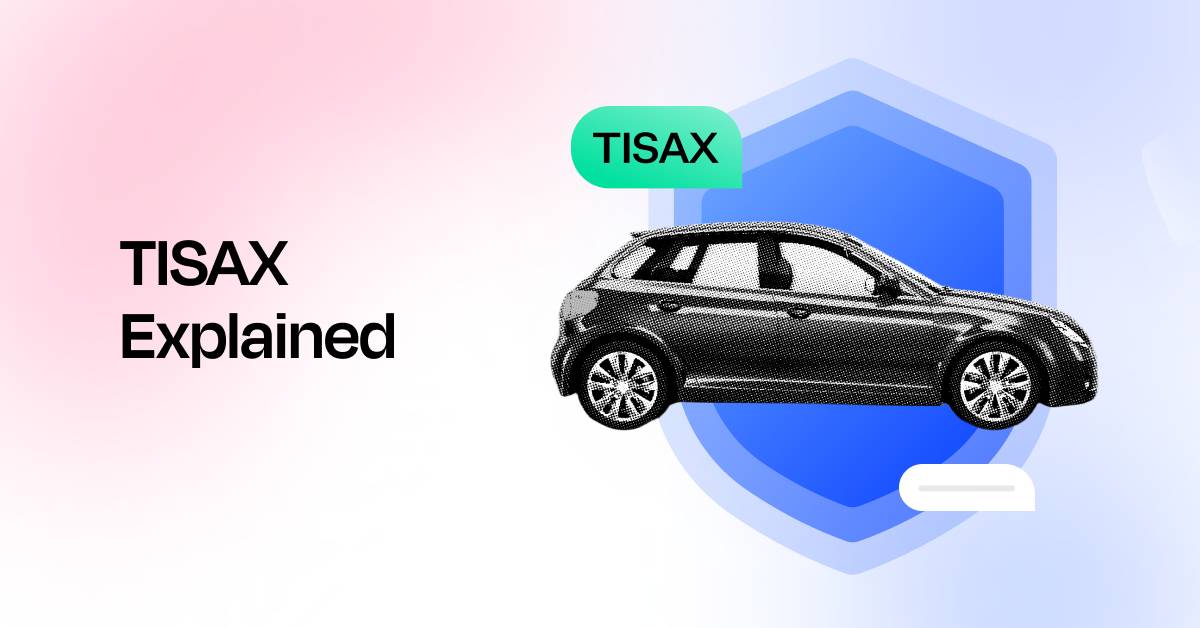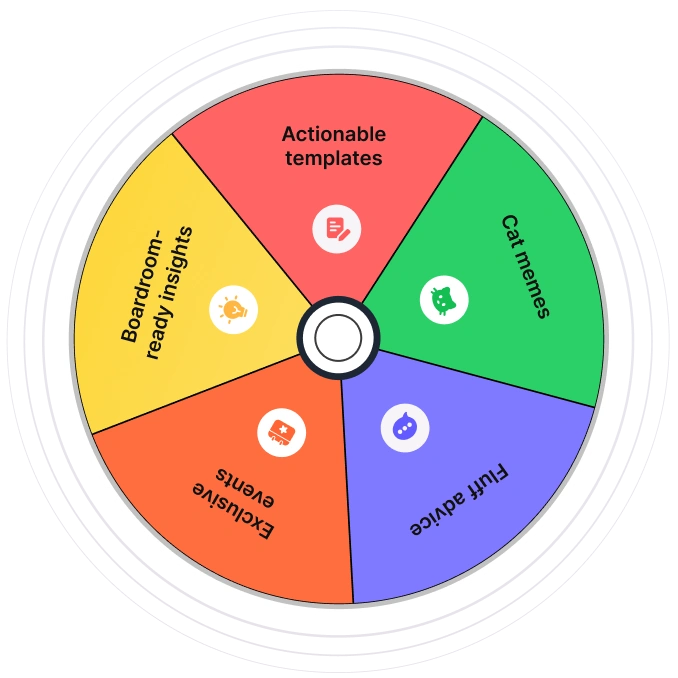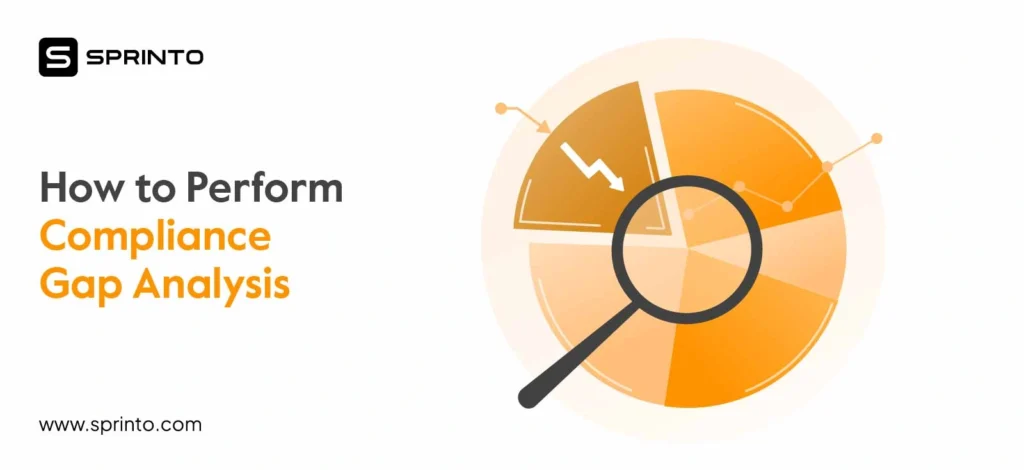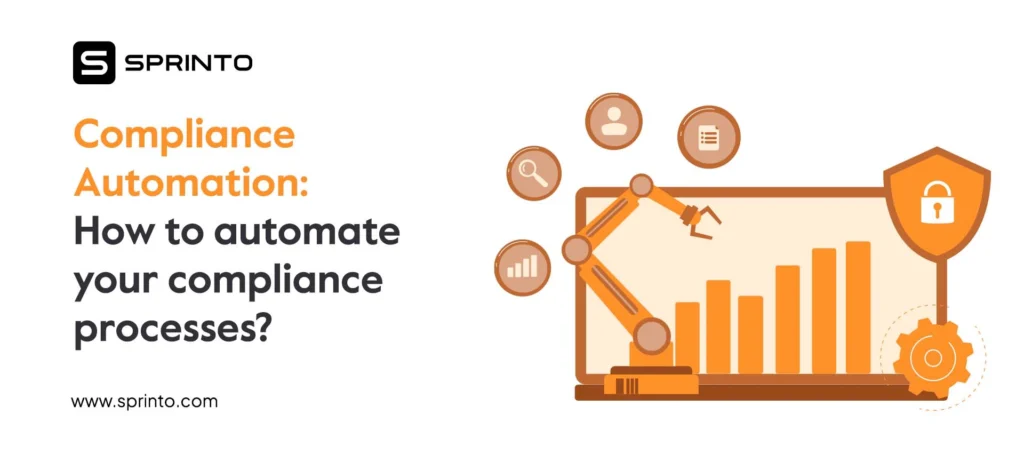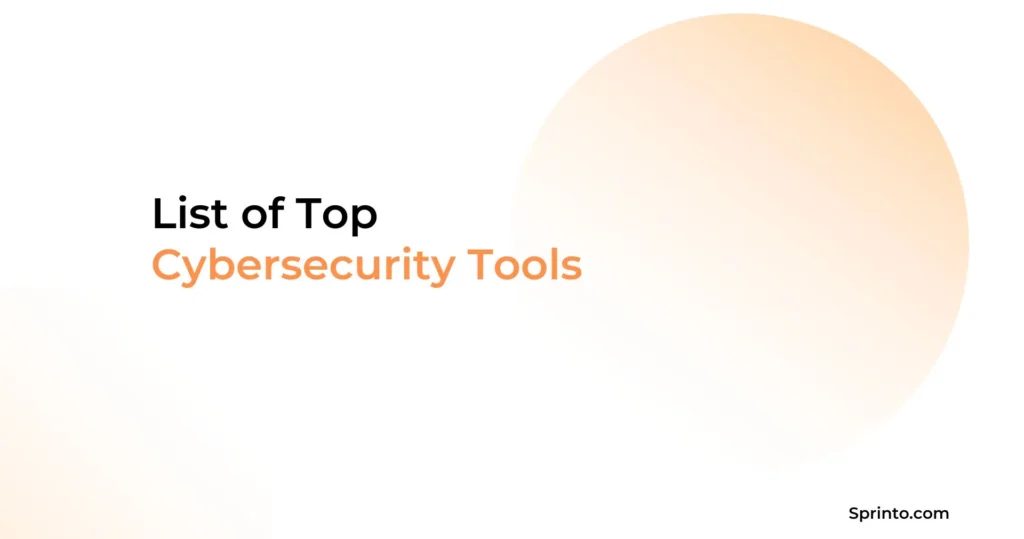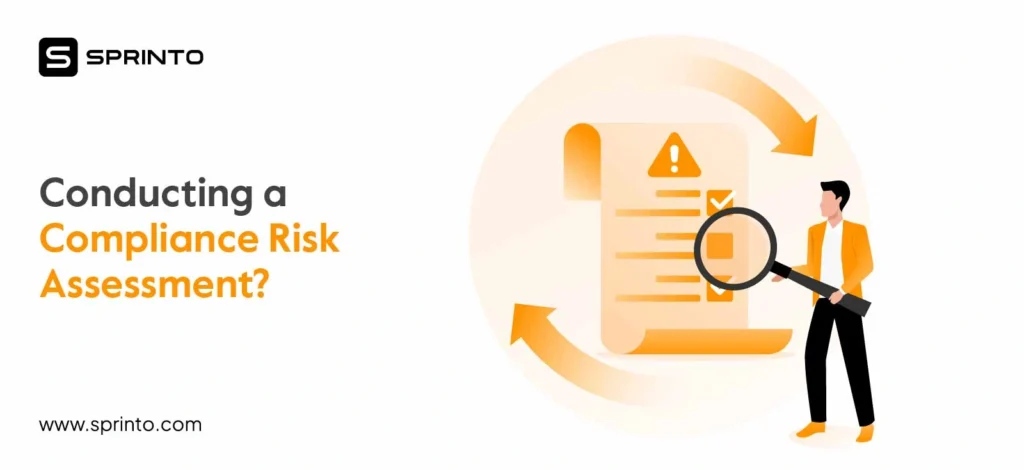The automotive industry is accelerating toward a future of autonomous vehicles, robotaxis, and connected mobility. But as innovation speeds up, so do cyber threats—95% of automotive cyberattacks are remote, posing risks like hijacked vehicles or compromised braking systems.
To secure this complex, data-driven landscape, the industry increasingly turns to TISAX (Trusted Information Security Assessment Exchange).
TISAX helps standardize how companies handle sensitive data by enforcing explicit assessment scopes, confidentiality levels, and a verifiable audit trail, making it a rising benchmark for building trust and resilience in modern mobility ecosystems.
TL;DR
| A vital security standard for the automotive sector, TISAX enhances data security and builds trust in the supply chain, offering cost-effective, standardized assessments recognized globally. |
| TISAX applies to OEMs, suppliers, and service providers. It has three assessment levels based on data sensitivity, ranging from self-assessments to comprehensive audits for sensitive data protection. |
| Certification involves preparation, registration with ENX, an external audit, and continuous improvements. Organizations undergo assessments based on their data sensitivity and security maturity across three levels of depth and complexity. |
What is TISAX?
TISAX (Trusted Information Security Assessment Exchange) is a globally recognized standard for information security, especially in the automotive industry. Developed by the German Association of the Automotive Industry VDA in collaboration with the ENX Association, the standard ensures secure data handling and information exchange across organizations.
The VDA sets out the security requirements in the information security assessment (ISA), and ENX oversees the certification process. The standard builds upon the established controls of ISO 27001, the gold standard for information security, while customizing them according to automotive industry needs.
What TISAX Aims to Achieve?
TISAX (Trusted Information Security Assessment Exchange) seeks to create a standard for checking and sharing information security in the automotive supply chain. It is based on ISO 27001 and tailors security controls to the industry’s needs.
The framework is designed to:
– Protect sensitive information like intellectual property, personal data, and confidential contracts.
– Allow secure and efficient teamwork between OEMs, suppliers, and service providers.
– Minimize audit fatigue with a single, widely accepted assessment.
– Boost market credibility and increase compliance transparency across the supply chain.
Why TISAX is Important for the Automotive Industry
While not required, TISAX has become a standard expectation for businesses that work with OEMs and Tier 1 suppliers. Here’s why:
– Better Data Protection: TISAX implements strong security measures to protect valuable automotive data from breaches.
– Sales Enablement: Certification builds customer trust and can help revive stalled deals or secure new contracts.
– Audit Efficiency: Multiple partners accept one TISAX assessment, reducing the need for repeated checks.
– Lower Implementation Costs: Companies already compliant with ISO 27001 can use existing controls, saving time and resources.
What are the Key Components of TISAX Frameworks
TISAX primarily targets companies in the European automotive industry supply chain that handle sensitive information. However, many multinational companies require global partners and suppliers to comply with TISAX. This makes it relevant for international organizations wishing to enter into business contracts with European firms.
The following entities fall under TISAX:
- Original Equipment Manufacturers (OEMs): Companies that develop, assemble, and market vehicles.
- Suppliers and sub-suppliers: Companies that provide parts, systems, and components for manufacturing vehicles. This also includes sub-suppliers that provide raw materials or components to leading suppliers.
- Service Providers: Organizations that offer services related to IT, engineering, consulting, and data processing and handle sensitive information
- Research and Development Firms: Organizations that are involved in prototype creation, design, or innovation
- Other partners: Companies offering logistics and transportation services
Other key aspects of TISAX Scope:
ISMS: Organizations must establish a fully compliant ISMS aligned with ISO 27001 and TISAX requirements.
Data Categories: Entities falling under TISAX must protect prototypes and product development data, operational and business process information, customers’ personal information, and third-party and partner information exchange.
What are the Assessment Levels of TISAX
Depending on the data’s sensitivity, the organization’s importance in the automotive supply chain, and the maturity of information security controls, TISAX conducts assessments at 3 levels. These levels represent the depth and scope of the assessment.
Let’s dive deep into these 3 levels:
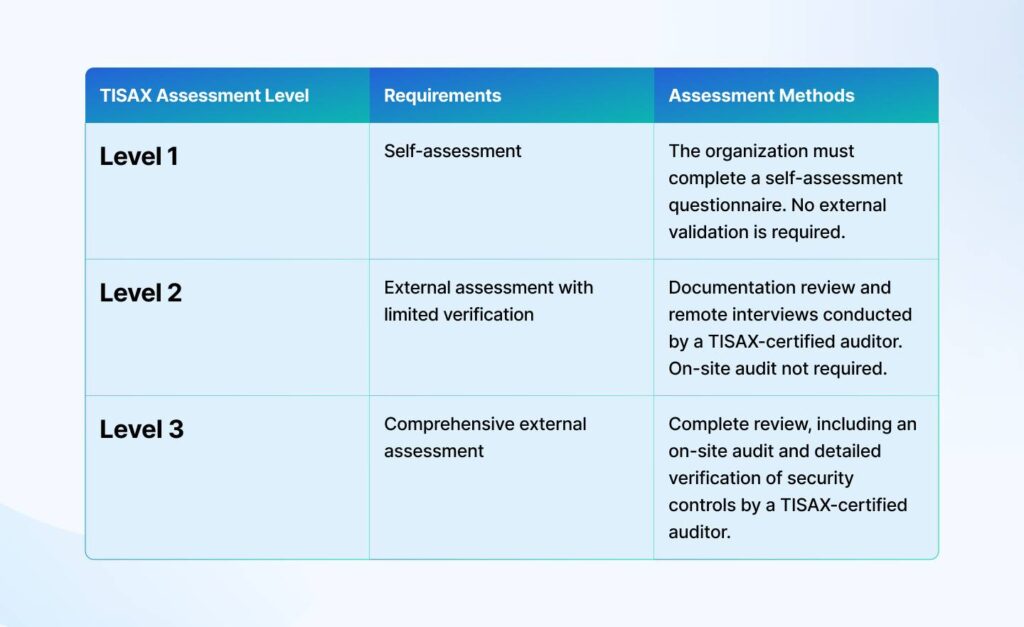
Assessment Level 1 (AL1)
This introductory level suits organizations that handle non-sensitive data such as general business information.
- Organizations must implement foundational security controls such as access controls and incident response plans
- Organizations complete a survey or a questionnaire as per the TISAX standard to undergo a self-assessment and prepare a self-assessment report
- No external verification or audit is required in this case
- No TISAX label is issued, and the self-assessment report is shared with clients on request
Assessment Level 2 (AL2)
AL2 is a slightly advanced level suitable for organizations handling medium-risk data, such as some personal data, supplier information, intellectual property, and internal communication.
- Organizations must implement additional security controls, such as data encryption, advanced access controls, regular security audits, a formalized incident response plan, and data integrity and protection protocols
- It requires a self-assessment and a partial evaluation conducted by a chosen TISAX-accredited auditor
- The auditor reviews documentation and may conduct interviews to identify any deficiencies
- The final report is issued by the auditor after gap remediation, and the organization receives a TISAX label
Assessment Level 3 (AL3)
Level 3 is for organizations that deal with highly sensitive data, such as prototype information, personal data protected under GDPR, critical systems data, or confidential information.
- Organizations must implement a mature ISMS and advanced measures such as advanced encryption standards, continuous monitoring, awareness training, risk assessments, and data loss prevention measures.
- It requires an on-site audit by the TISAX-accredited auditor
- The auditor conducts an in-depth evaluation of the controls and issues a TISAX label
- Leading automotive manufacturers require AL3 as it offers the highest level of assurance
Exchange Size and Growth of TISAX
TISAX is currently said to be the second most widely adopted information security standard. Over the years, its adoption has expanded beyond the automotive industry, and organizations across the globe are realizing its value in data protection and strengthening partnerships.
- Number of Registered Participants: Over 10,000 locations have been assessed across 80 countries, with more than 3000 registered TISAX participants. The increasing number of companies joining the network highlights the strong demand for trusted suppliers in the automotive industry who have undergone formal assessments.
- Regional and Global Reach: TISAX is expanding its influence across other regions, especially North America and Asia, after establishing a strong foothold in the European automotive industry. AWS has recently achieved TISAX certification across 19 regions and is a notable example of how the standard is globally recognized for information security in supply chains.
- Industries Beyond Automotive: TISAX requirements are recognized as valuable beyond the automotive sector because of its strong emphasis on information security. Sectors such as aerospace, rail manufacturing, energy, and defense also adopt TISAX principles to safeguard sensitive information.
Ensure a robust ISMS with Sprinto
The Roadmap to Achieving TISAX Certification
For TISAX attestation, the VDA suggests you take a self-assessment using the ISA (Information Security Assessment) questionnaire. It’ll help you understand your ISMS’s maturity level.
The ISA also ranks these maturity levels from 0 (incomplete) to 5 (optimizing) based on whether or not structured processes are in place. Organizations must reach a minimum of level 3 (established) to receive the TISAX label.
The TISAX certification process has 4 phases:
1. Preparation
The preparation phase involves the following steps:
Familiarize yourself with the requirements
Begin by understanding the TISAX requirements and familiarizing yourself with the VDA questionnaire, which covers data protection and prototyping security.
Determine the scope and assessment level
Next, identify the systems and processes eligible for evaluation and determine the assessment level based on the sensitivity of the information you handle.
Conduct a review of existing policies and processes
Identify the weaknesses in your ISMS and review existing policies and processes to pinpoint the gaps per TISAX requirements. This is like a self-assessment to understand your current security maturity. Some common areas of improvement include risk assessments, access controls, incident response plans, and data protection controls.
Remediate the gaps
Implement the required security enhancements such as encryption, MFA, data classification policies, and role-based access controls. Also, train your employees on security best practices and create solid documentation of corrective actions.
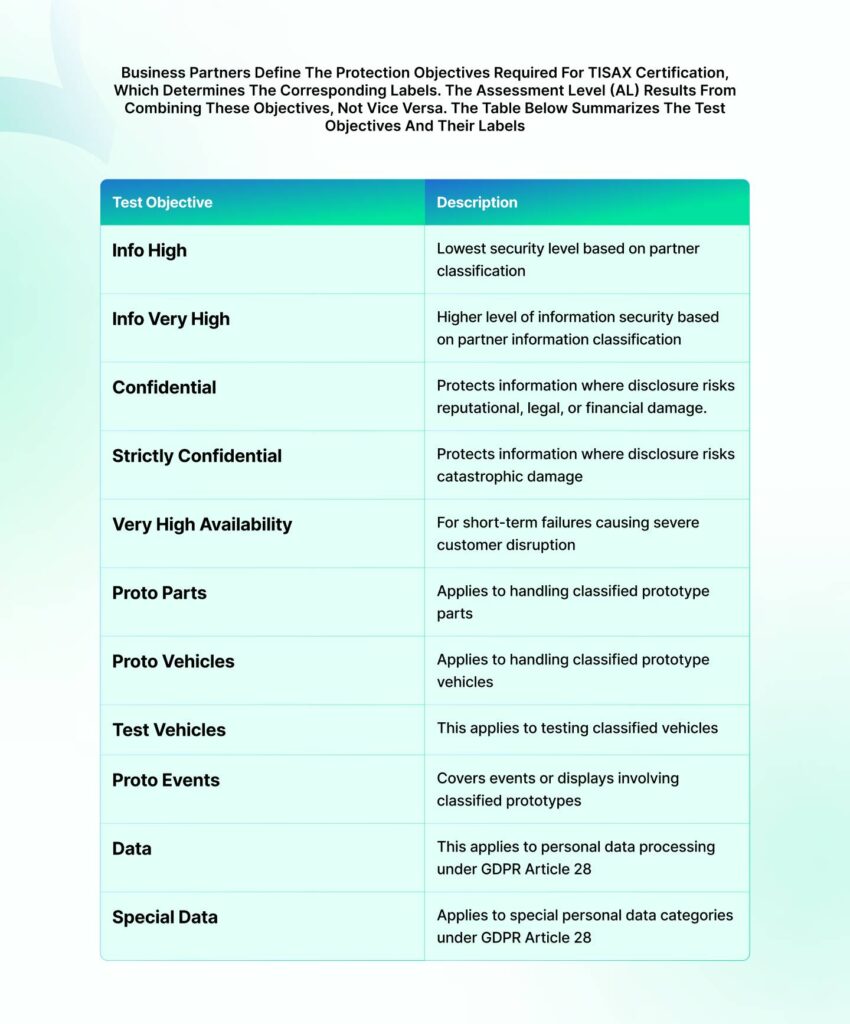
2. Registration
Go to the ENX Association website and create an account on the TISAX portal for registration. You’ll be required to enter details such as the organization’s name and contact information, scope of assessment, and assessment levels. From the portal, choose a TISAX-accredited audit provider and agree on terms such as timeline and costs.
3. Assessment by an accredited auditor
Coordinate with the chosen TISAX auditor regarding the audit scope, schedule, and documentation. The auditor will conduct an in-depth assessment of the ISMS, security measures, and prototyping security as part of compliance verification against TISAX objectives.
The auditor compiles a report with detailed findings after interviews with staff, process walkthrough, and documentation review.
For any gaps identified, the organizations have nine months to implement remediation and undergo follow-up assessments.
If the organization meets the criteria, the auditor submits the report to ENX, and the company gets a TISAX label. You can selectively share the results with trusted partners through the ENX portal, as the results are not public for everyone.
4. Ongoing Monitoring and Improvements
Once you’ve received the label, you will only be reassessed after 3 years. However, you must display an ongoing commitment to security. Establish a continuous monitoring mechanism to proactively address security gaps and regularly review and update your ISMS to minimize risks.
TISAX vs ISO 27001: Key Differences
While TISAX builds on ISO 27001, there are several key differences between the two:
| Feature | TISAX | ISO 27001 |
| Industry Focus | Automotive-specific | Industry-agnostic (applies across all sectors) |
| Governing Body | VDA (requirements) + ENX (oversight) | International Organization for Standardization (ISO) |
| Assessment Approach | Three-tiered (AL1, AL2, AL3) based on data sensitivity | Single-level certification |
| Audit Model | Varies by level – from self-assessment to full external audit | An external audit is required for certification |
| Confidentiality Levels | Explicit confidentiality levels are set per scope and data type | The organization defines confidentiality requirements |
| Exchange Network | Results shared selectively through the ENX portal | No standardized platform for result sharing |
| Recognition in Automotive | Widely accepted and often expected by OEMs and suppliers | Often a prerequisite, but not tailored to automotive needs |
In essence, TISAX tailors ISO 27001 for the automotive industry. It streamlines compliance, cuts down on repetitive audits, and fosters trust within the automotive exchange network.
Preparing for the AI-Driven Future: Why TISAX Matters More Than Ever
As the popularity and demand for AI-driven autonomous vehicles grow— with 3.5 million autonomous vehicles projected in the United States alone by 2025— the role of TISAX becomes more critical than ever.
AI-powered vehicles rely on vast data, including driver behavior and infrastructure information, to train and perform effectively. TISAX-certified companies are better positioned in this rapidly evolving landscape for risk mitigation as AI introduces new legal and cybersecurity challenges.
By adhering to TISAX, organizations can enhance their cybersecurity posture and implement preventive and detective measures to ensure secure information exchange for AI applications.
TISAX can also work in tandem with regulations such as the EU AI Act and support secure and ethical handling of AI. Companies that use both in alignment can future-proof themselves in the fast-growing AI landscape and the world of automotive innovation.
How can Sprinto be an enabler in the journey?
If you feel that your competition is already gearing up for TISAX compliance and the pressure to stay ahead is mounting, we get it. The sheer amount of documentation, control checks, self-assessments, and continuous monitoring can be overwhelming. And when you are trying to unblock a sales deal, you need things to move fast. Enter Sprinto.
The next-gen GRC platform can help you build a fully compliant ISMS without stopping or losing critical bandwidth. Use the control library and automated mapping, pre-built policies, training modules, integrated risk assessments, automated evidence collection, and a host of other features to streamline and scale compliance. The dashboard will help you understand where you stand and which areas need extra attention.
Sprinto also offers out-of-the-box support for ISO 27001, laying the foundation of TISAX.
Talk to an expert to understand how Sprinto can help you accelerate compliance.
FAQs
What is the difference between TISAX objectives and TISAX labels?
TISAX objectives are the security and compliance areas for which the organization is assessed, while TISAX labels indicate that the organization meets the corresponding objectives.
How long is TISAX valid for?
TISAX assessment results are valid for 3 years.
Are there any intermittent checks during the validity period?
No, there are no intermittent checks or surveillance audits during the 3 years of TISAX validity. The renewal process starts at the end of the validity period.
What is the difference between TISAX and ISO 27001?
ISO 27001 is a generic information security standard, while TISAX is specifically tailored for the automotive industry. The former takes a one-certification-level approach, while TISAX has a three-level assessment approach.
How much does TISAX cost?
The mandatory registration fee is €500, while the audit provider fee ranges from €5,000 to €10,000. The preparation costs, including implementing a fully compliant ISMS, consultation, and other technology upgrades, can bring the total costs to €20,000 to €50,000.
Payal Wadhwa
Payal is your friendly neighborhood compliance whiz who is also ISC2 certified! She turns perplexing compliance lingo into actionable advice about keeping your digital business safe and savvy. When she isn’t saving virtual worlds, she’s penning down poetic musings or lighting up local open mics. Cyber savvy by day, poet by night!
Explore more
research & insights curated to help you earn a seat at the table.



